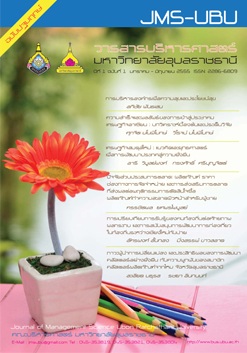The Comparison of Residents’ Perceptions of Potential, Impact and Local Support for Local Tourism Development between Chiang Mai and Pai
Main Article Content
Abstract
The objective of this article is to compare the causal relationship of the residents’ perceptions of destination tourism potential, the impact of tourism, and the support for local tourism development between Chiang Mai and Pai. A Structural Equation Model (SEM) was used to analyze the data. The model contains 15 observable variables; four exogenous latent variables (destination tourism potential, economic impact, social and cultural impact, and environmental impact); and one endogenous latent variable (the support for local tourism development).
The study found that local residents consider that private cooperation and support from local government are an important component of the support for local tourism development. Economic impact is the main factor influencing the support for local tourism development, but the magnitude of influence varies by destination. An employment opportunity for local people is significant economic impact of both destination, and local resident in both destination prefer the continuous development in the physical attractions and amenities. While social-cultural and environmental impacts create a little concern to local resident. The results of this study reflect that different destination should have different tourism development policy under the participation of all sector to achieve the sustainability of local tourism development.
Downloads
Article Details
References
Akis, S., Peristianis, N. & Warner, J. (1996). Residents’ attitudes development: The case of Cyprus. Tourism Management, 17(7), 481-494.
Allen, L. R., Long, P. T., Perdue, R. R. & Kieselbach, S. (1988). The impacts of tourism development on residents’ perceptions of community life. Journal of Travel Research, 27(1), 16-21.
Ap, J. (1990). Residents’ perceptions research on the social impacts of tourism. Annals of Tourism Research, 17(4), 610-616.
Bastias-Perez, P. & Var, T. (1995). Perceived impacts of tourism by residents. Annals of Tourism Research, 22(1), 208-210.
Butler, R. W. (1980). The concept of a tourism areas cycle of evaluation: Implication for management of
resources. Canadian Geographer, 24(1), 5-12.
Chen, J. S. (2001). Assessing and visualizing tourism impacts from urban residents’ perspectives. Journal
of Hospitality & Tourism Research, 25(3), 235-250.
Cooke, K. (1982). Guidelines for socially appropriate tourism development in British Columbia. Journal of
Travel Research, 21(1), 22-28.
Dyer, P., Gursoy, D., Sharma, B. & Carter, J. (2007). Structural modeling of resident perceptions of tourism and associated development on the Sunshine Coast, Australia. Tourism Management, 28(2), 409-422
Getz, D. (1994). Residents' attitudes toward tourism: A longitudinal study in Spey Valley, Scotland. Tourism
Management, 15(4), 247-258.
Gursoy, D., Jurowski, C. & Uysal, M. (2002). Resident attitudes: A structural modeling approach. Annals of
Tourism Research, 29(1), 79-105.
Hair, J. F., Black, W. C., Babin, B. J. & Anderson, R. E. (2010). Multivariate Data Analysis, 7th ed. New Jersey: Prentice-Hall International.
Jurowski, C., Uysal, M. & Williams, D. R. (1997). A theoretical analysis of host community resident reactions to tourism. Journal of Travel Research, 36(2), 3-11.
Kaosa-ard, M. (2007). Mekong Tourism: Blessings for All?. Bangkok: White Lotus.
Ko, D. W. & Stewart, W. P. (2002). A structural equation model of residents’ attitudes for tourism
development. Tourism Management, 23(5), 521-530.
Kreag, G. (2001). The Impacts of Tourism. Retrieved October 10, 2008, from http://www.seagrant.umn.edu/tourism/pdfs/ImpactsTourism.pdf.
Lankford, S. V. & Howard, D. R. (1994). Developing a tourism impacts attitude scale. Annals of Tourism
Research, 21(1), 121-139.
Lawton, L. (2005). Resident perceptions of tourism attractions on the Gold Coast of Australia. Journal of Travel Research, 44(2), 188-200.
Lepp, A. (2007). Residents’ attitudes towards tourism in Bigodi village, Uganda. Tourism Management,
(3), 876-885.
Lindberg, K. & Johnson, R. L. (1997). Modeling resident’s attitude toward tourism. Annals of Tourism Research, 24(2), 402-424.
Liu, J. C. & Var, T. (1986). Resident attitudes toward tourism impacts in Hawaii. Annals of Tourism Research, 13(2), 193-214.
Nunnally, J. C. & Bernstein, I. H. (1994). Psychometric theory (3rd ed.). New York: McGraw-Hill.
Parasuraman, A., Zeithaml, V. & Berry, L. (1988). SERVQUAL: A multiple-item scale for measuring consumer perceptions of services quality. Journal of Retailing, 64(1), 12-40.
Perdue, R. R., Long, P. T. & Allen, L. (1990). Resident support for tourism development. Annals of Tourism
Research, 17(4), 586-599.
Ritchie, J. R. B. (1988). Consensus policy formulation in tourism: Measuring resident views via survey
research. Tourism Management, 9(3), 199-212.
Untong, A. (2006). Attitude of local residents on tourism impacts: A case study of Chiang Mai and Chiang
Rai. Proceeding 12th Asia Pacific Tourism Association and 4th APacCHRIE Joint Conference, June
-29 2006. Hualien, Taiwan.
Untong, A., Phuangsaichai, S., Taweelertkunthon, N. & Tejawaree, J. (2006). Income distribution and
community based tourism: Three case studies in Thailand. The Journal of GMS Development
Studies, 3(1), 69-81.
Yoon, Y., Gursoy, D. & Chen, J. S. (2001). Validating a tourism development theory with structural equation
modeling. Tourism Management, 22(4), 363-373.
